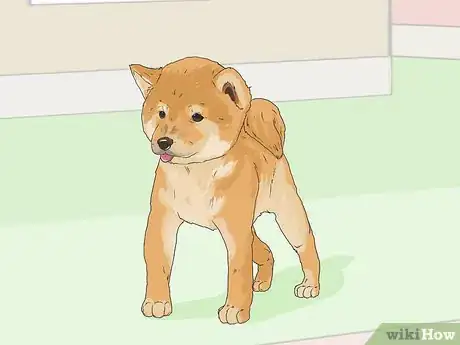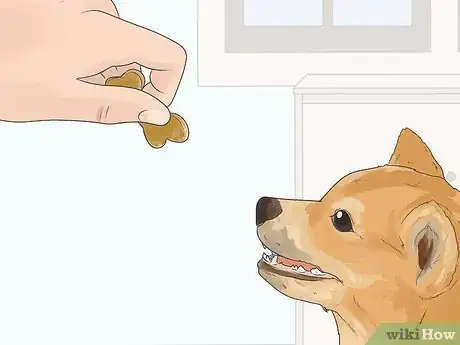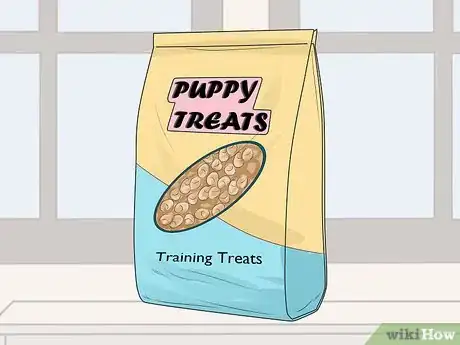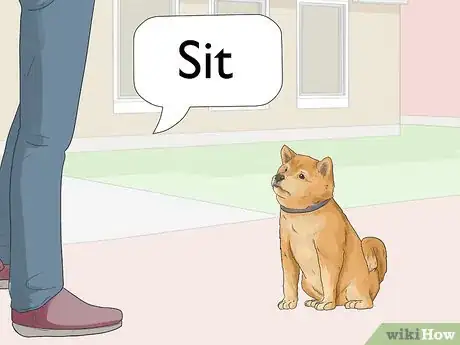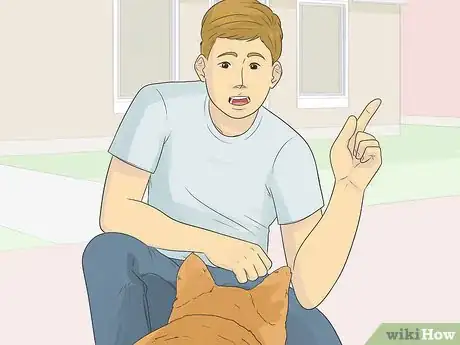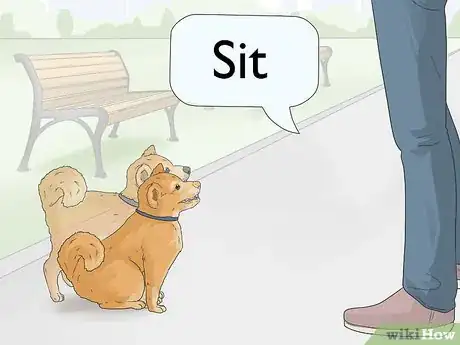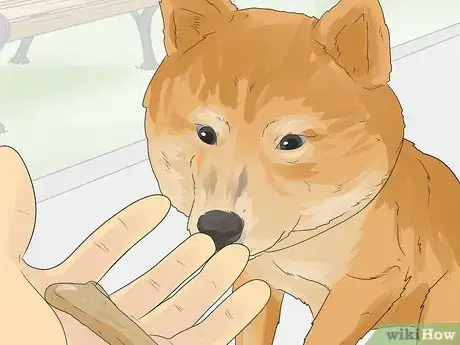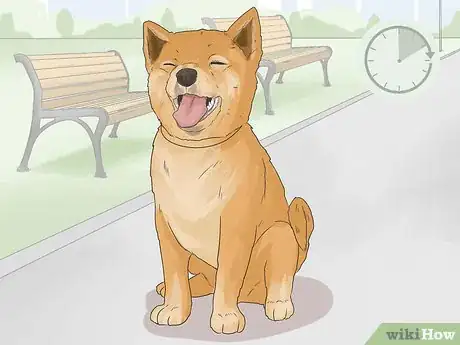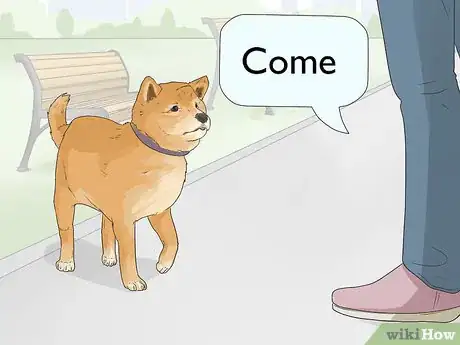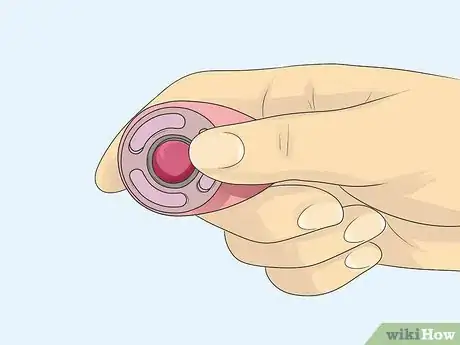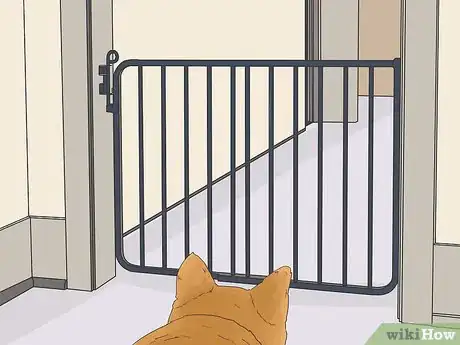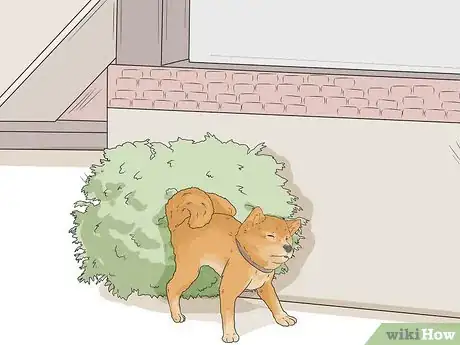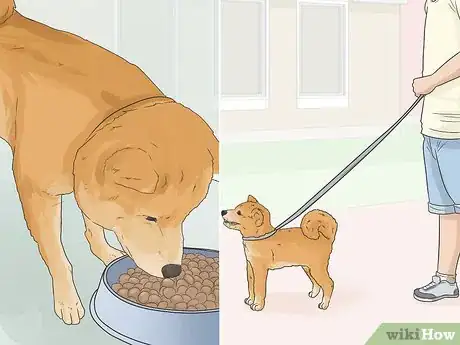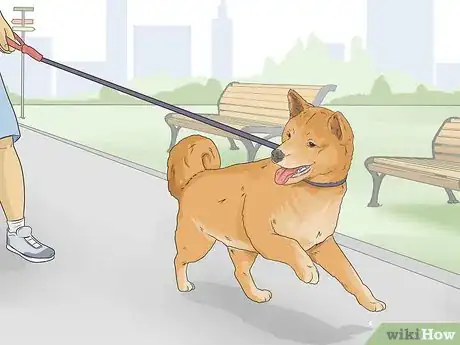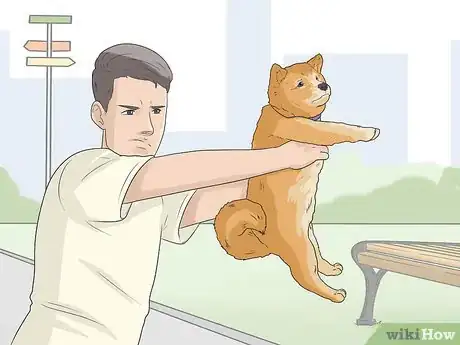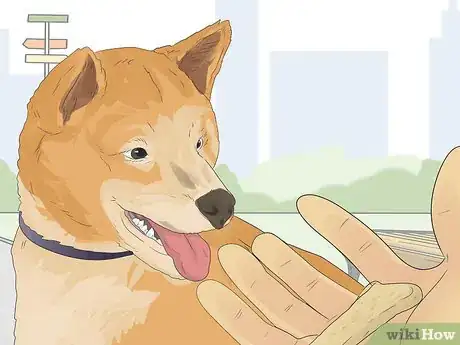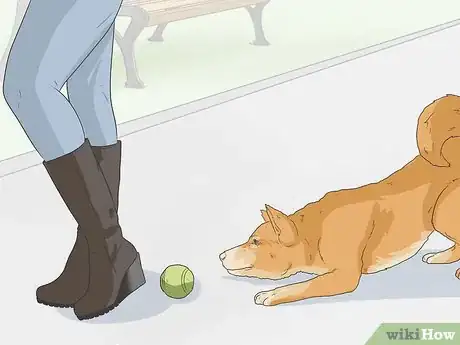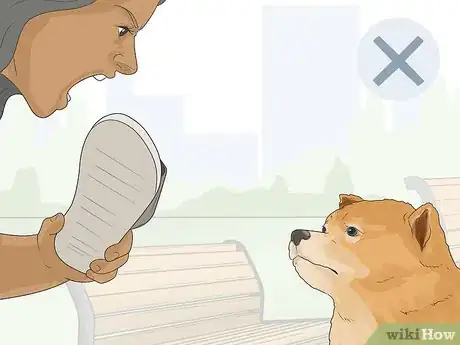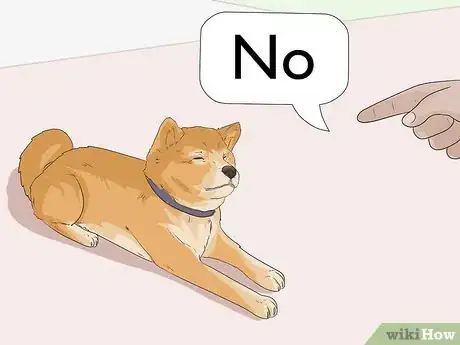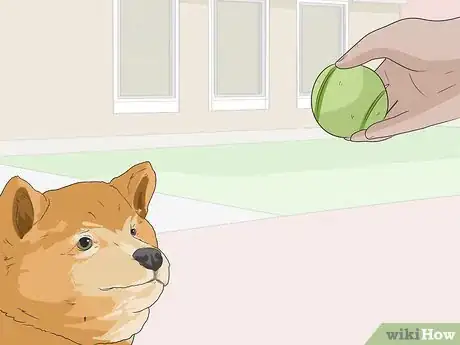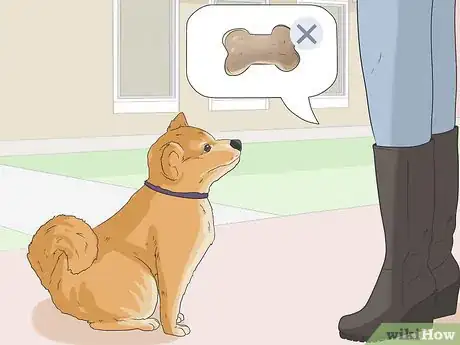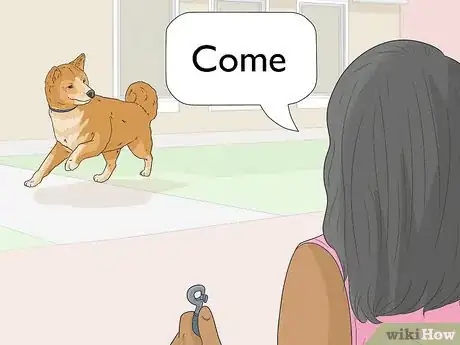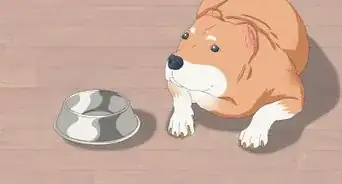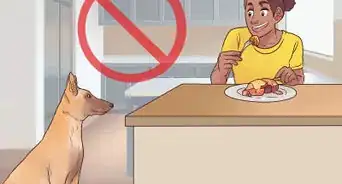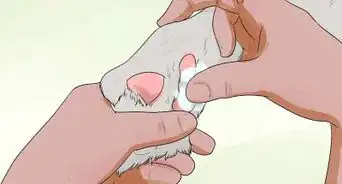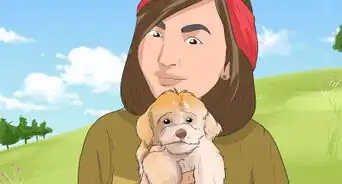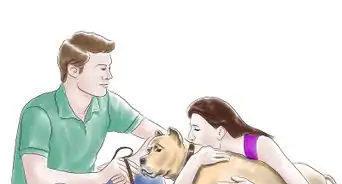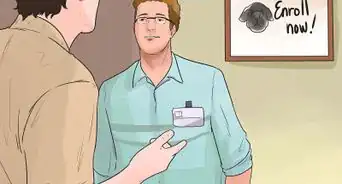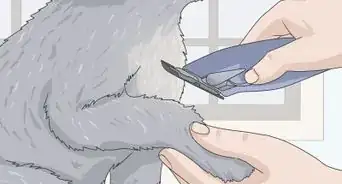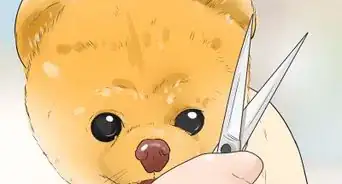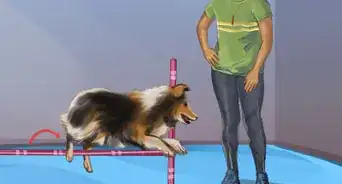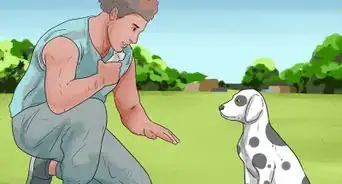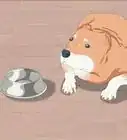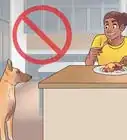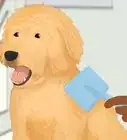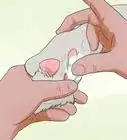This article was co-authored by Pippa Elliott, MRCVS and by wikiHow staff writer, Amber Crain. Dr. Elliott, BVMS, MRCVS is a veterinarian with over 30 years of experience in veterinary surgery and companion animal practice. She graduated from the University of Glasgow in 1987 with a degree in veterinary medicine and surgery. She has worked at the same animal clinic in her hometown for over 20 years.
There are 12 references cited in this article, which can be found at the bottom of the page.
This article has been viewed 24,645 times.
Shiba Inus are small, attractive dogs that resemble foxes. Despite their good looks and popularity, they are independent, notoriously stubborn and hard to train. However, with consistency and patience, you can train your Shiba Inu to follow basic commands, go to the bathroom outside, and obey your rules about behavior.
Steps
Teaching Verbal Commands
-
1Start training a Shiba Inu puppy as early as possible. Eight weeks old is the ideal age to begin training this breed. If your Shiba puppy is already older than that, get started right away! Shiba Inus are very intelligent, but their strong personalities and unique temperament can make training difficult. Training during their critical developmental phase is much easier and the results will be better.
- If your Shiba isn't a puppy, you can still train it! Just keep in mind that it will take a little extra patience and effort to train an adult.
- A Shiba Inu requires lots of mental stimulation to prevent boredom, which affects its attention span. Play with your dog regularly, take it on walks daily, give it puzzle feeders, and avoid leaving it alone for long periods of time.
Tip: Try taking your dog for a walk before each training session. This will help it to work off some of its excess energy so it won’t be too energetic to pay attention. However, avoid playing with the dog too much before training sessions as this may cause it to become overexcited.
-
2Use positive reinforcement when training a Shiba Inu. Positive reinforcement training involves giving your Shiba a reward when it does what you want it to.[1] Tasty food is the best motivator for this breed since they don't crave praise and attention from their owners in the same way that many other dog breeds do.
- Shibas are notoriously stubborn and strong-willed. They don’t respond well to punishment models of training that discourage behaviors with negative repercussions.
- Positive reinforcement works well for Shiba Inus because it gives them the freedom to choose what to do.
Advertisement -
3Buy training treats to give your dog an incentive to follow your cues. Shibas are motivated by food, so the best incentive is a tasty treat. Training treats, which are meant to be used specifically for training, can be purchased at your local pet store or from online retailers.[2]
- Make sure your dog really likes the taste of the treats and only use them for training. That way, your dog will associate that particular tasty treat with training and good behavior.
- Training treats are designed to be low in calories but high in flavor, so don't worry too much about overfeeding your dog.
- Try to keep training treats on hand anytime you spend time with your dog. That way you can reward your dog for their good behavior when you are out together.[3]
Tip: Over the course of training your dog, try out different brands of treats to see if there is a specific product that your dog is highly motivated to get.
-
4Start with one specific command, such as "sit." Choose an easy word for each command and use the same word consistently to help your dog understand. Most people start with the "sit" command because it is relatively easy to teach and can be useful for getting your dog to stop and focus on additional commands.[4]
- While "sit" works well as a first command, you can pick something else, like "stay," "heel," or "lay down," if you want to.
-
5Say the command clearly and use a calm tone of voice. Never raise your voice or use an angry tone to teach a Shiba a verbal command. They will not respond well to this! Always say the word clearly and distinctly using a calm tone. Don't let irritation creep into your voice if training isn't going well! Strive to keep your cool around this breed.[5]
-
6Say the command before your dog performs the action to help it understand. One of the easiest ways to help your dog understand a verbal cue word is to say the command when the dog is naturally about to do that action. If you say the word right as the dog is performing the action, it will start to associate that action with the word you are saying.[6]
- For example, when you are taking your Shiba on a walk and you come to a stop at a corner, say the word “sit” right as the dog begins to fold its legs to sit. Do this every time you come to a stop to teach your dog the connection between the action and the word.
-
7Give your dog a treat as soon as it performs the action. Positive associations are best created in the moment, so be sure to give your dog a treat as soon as it obeys the command. Repeat the command and give it another treat when it obeys you. Your Shiba will quickly learn that good behavior gets them a tasty treat!
-
8Limit daily training sessions to about 10 minutes for the best results. Brief sessions work much better than longer ones, so aim for 10-15 minutes per session. Be consistent with your practice sessions and focus on teaching your dog a single command at a time.[7]
- You can do training once per day or, if you want to work with your dog a little more, try 10 minutes in the morning and 10 minutes in the evening.
- Short, frequent training sessions also work well, such as during the advertisements while you’re watching TV in the evening.
- Doing reward training daily will create a very strong bond between you and your dog. Make sessions as fun as possible no matter how often you decide to train your dog. Never punish your dog for not doing things properly during a training session.
-
9Introduce a new command after your dog masters the first one. Once your Shiba responds reliably to the "sit" command, start training it to follow another command. Use the same basic technique of positive reinforcement. Say the verbal cue and give the dog a treat when it completes the action correctly. Repeat this process until the dog masters the new command. Then, keep adding new commands![8]
- Remember to introduce new commands when your dog is already performing similar movements to help it understand. For example, when the dog starts moving towards you, call its name and say “come." When it gets to you, give it a treat and praise.[9]
-
10Try clicker training to explore other training techniques. Treat training is very effective, but it's not the only option! Clicker training can be a great alternative. Pick up a clicker at your local pet store and introduce it to your dog. Instead of giving the dog treats, teach it to associate the clicking sound with praise and good behavior.[10]
- The clicker is a great way to transition your dog from treat training since extensive treat training could eventually cause weight gain.
Housebreaking a Shiba Inu Puppy
-
1Limit the puppy’s movement around the home. Keep the puppy in the room with you and don’t let it wander away too far from you. You can even put a collar on the puppy, attach a leash, and hook the end of the leash around your arm.[11] This way you will know when the puppy moves away from you and starts sniffing to urinate. Another option is to put up dog gates and close doors to keep the puppy from wandering off. When you are not home, keep your puppy in a crate or a contained area, such as a bathroom.[12]
- When housebreaking a puppy, you need to keep an eye on it all of the time so you can act quickly.
- Crating works well because the puppy will not want to go to the bathroom in a small space like a crate.[13]
-
2Pick an outside bathroom spot for your Shiba to use. Pick a spot that is easily accessible and close to your home. Take your dog to this specific spot every time you want it to go to the bathroom. Be consistent so that your dog will associate that special area with going to the bathroom.[14]
- A grassy spot will work best for this.
-
3Take your dog out after each meal. Be sure to take your dog out even if it shows no need to go to the bathroom. Most dogs need to go to the bathroom relatively quickly after eating, so it’s important to give your Shiba the chance to go outside at that time. This is especially true for puppies!
- Once your puppy is about 4 months old, let it out at specific times each day. Pick a specific time in the morning, afternoon, and evening and go out at those times no matter what.
- Be sure to take your puppy to the toilet spot every 20 minutes. This will increase the chances that they’ll be in the toilet spot when they have to go.
-
4Keep a consistent schedule for letting your Shiba out. Housebreaking a Shiba is easier once it learns when it will get to go out. A young puppy needs to go out every hour. A good rule of thumb is to add 1 hour for every month of age. So a 2-month-old puppy can probably wait 2 hours and a 4-month-old puppy can probably wait 4 hours.[15]
- The dog’s body will get used to the elimination schedule if it's consistent. If you take your dog out erratically, the dog’s digestive system will never have a chance to get on a reliable schedule.
- Stay on schedule on the weekend. Your puppy’s digestive system doesn’t know the difference between a weekday and the weekend!
-
5Take your Shiba out if you think it’s about to go to the bathroom.[16] If you see your puppy sniffing around or starting to squat, say "no" in a calm voice and immediately take it outside to its bathroom area. Even if the puppy is in the middle of going to the bathroom, pick it up and take it outside.[17]
- If your puppy has already gone to the bathroom in your home, remain calm. Rubbing their nose in it or yelling will only confuse the puppy and build distrust.
Tip: If your Shiba does have an accident inside, clean up the area thoroughly to eliminate odors. If odors are left behind, your dog may think that is a place where it should repeatedly go to the bathroom.
-
6Give tasty treats and positive reinforcement for successful bathroom breaks. Once your puppy goes to the bathroom successfully, say “good job” in a pleasant tone. You can also give it a special treat after a successful potty break. Praise and treats will help reinforce that the puppy did a good thing by going to the bathroom outdoors.[18]
- Be consistent and do this every time you take your puppy out so the behavior will stick.
Eliminating Bad Behaviors
-
1Respond to bad behaviors by ignoring the dog's desire for attention. Shibas get bored easily and will try to get any kind of attention. It doesn't necessarily have to be good attention! In fact, negative attention tends to last longer, so your dog might actively seek that out. The best option when this happens is to ignore your dog. That way, it will learn that poor behavior isn't the way to get what it wants.[19]
-
2Avoid yelling, physical restraint, and aggression when disciplining your dog. Shibas will fight back if they're physically punished or restrained, which encourages rough play, aggression, and biting. When your dog misbehaves, stay calm and avoid backing away or showing fear. Don't engage in a physical competition of any kind with a Shiba.[20]
- This doesn’t mean you shouldn’t use a firm voice when telling your dog to stop a negative behavior. You simply need to stay calm while you are directing it.
Tip: Using positive reinforcement and redirection will build trust and love with your dog, while physical or emotional punishment will make your dog less trusting of you.
-
3Stop bad behaviors immediately when you notice them. If you see your Shiba doing something it shouldn’t, stop them right away by saying "no" or redirecting their attention. Because Shiba Inus are stubborn, it can be hard to break them of bad behaviors once they are established. Don’t let them get away with chewing, barking, or doing other things they shouldn’t be doing or you will have a bigger problem on your hands.[21]
- It can be tempting to let bad behavior slide once in a while, such as if you’re tired or running out the door. However, when you don’t stop a bad behavior, that is as good as giving your dog permission to do it.
-
4Redirect your Shiba’s attention when it’s behaving badly. If your dog isn’t responding to you saying "no," pick an activity they like doing and direct them towards that. Getting your Shiba to chase a ball or to come to you for petting is a great way to stop negative behavior, such as compulsive barking or chewing.
- For example, if your Shiba is chewing on a shoe, find something else that is appropriate for your dog to chew on, like a chew toy or squeaky toy. Offer the toy and encourage your Shiba to chew on it instead.
-
5Be consistent with which behaviors you don’t allow to establish rules. Shibas tend to be dominant, so creating specific rules about what you do and don't allow is crucial. Stop your dog any time it starts to break a rule to reinforce it and be consistent to help your dog understand.
- For example, if you don’t want your Shiba to beg, don’t ever feed it when it begs for treats. Giving it a treat sometimes and admonishing it at other times will confuse your dog.
-
6Work within your Shiba’s limitations. Shiba Inus have many wonderful character traits, but they also have some characteristics that can be a little challenging for their owners! In most cases, you won’t be able to completely eliminate these characteristics, such as being unreliable off-leash, so you’ll need to learn to work around them.[22]
- In the example of being unreliable off-leash, don’t try to train your Shiba to be a free-roaming dog. Instead, work on the "come" command, so that it’s safe if it accidentally gets off the leash.
References
- ↑ Ty Brown. Dog Trainer. Expert Interview. 4 June 2020.
- ↑ https://www.akc.org/expert-advice/training/training-your-dog-with-rewards-and-positive-reinforcement/
- ↑ Ty Brown. Dog Trainer. Expert Interview. 4 June 2020.
- ↑ https://www.akc.org/expert-advice/training/training-your-dog-with-rewards-and-positive-reinforcement/
- ↑ https://www.shibarescue.org/is-a-shiba-right-for-you
- ↑ https://www.akc.org/expert-advice/training/training-your-dog-with-rewards-and-positive-reinforcement/
- ↑ https://www.akc.org/expert-advice/training/training-your-dog-with-rewards-and-positive-reinforcement/
- ↑ https://www.akc.org/expert-advice/training/training-your-dog-with-rewards-and-positive-reinforcement/
- ↑ https://wagwalking.com/training/train-a-shiba-inu-to-come
- ↑ https://www.akc.org/expert-advice/training/what-is-clicker-training-a-great-way-to-shape-your-dogs-behavior/
- ↑ Ty Brown. Dog Trainer. Expert Interview. 4 June 2020.
- ↑ https://shibashake.com/dog/puppy-potty-training-facts-and-myths
- ↑ http://www.vetstreet.com/our-pet-experts/housebreaking-a-puppy-7-tips-from-a-trainer
- ↑ https://shibashake.com/dog/puppy-potty-training-facts-and-myths
- ↑ https://shibashake.com/dog/puppy-potty-training-facts-and-myths
- ↑ Ty Brown. Dog Trainer. Expert Interview. 4 June 2020.
- ↑ https://shibashake.com/dog/puppy-potty-training-facts-and-myths
- ↑ https://inushiba.org/tag/how-to-train-a-shiba-inu-off-leash/
- ↑ https://shibashake.com/dog/why-are-shiba-inus-one-of-the-most-difficult-breeds-to-train
- ↑ https://shibashake.com/dog/shiba-inu-training-secrets
- ↑ https://shibashake.com/dog/how-dogs-learn-how-dogs-think
- ↑ https://www.akc.org/dog-breeds/shiba-inu/
- ↑ Ty Brown. Dog Trainer. Expert Interview. 4 June 2020.
